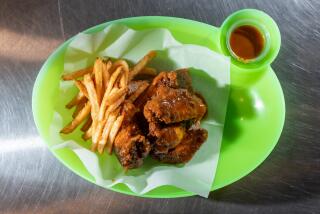Horseradish: The Mightiest Root
- Share via
Most of us associate horseradish with Central European cooking. Its spiciness foils the unctuous mouth-feel of the fatty cuts of beef so popular there. And there’s nothing more divine than dissolving prepared horseradish into a bowl of boiled beef short ribs.
I can’t really enjoy a rare roasted rib of beef without the traditional horseradish sour cream that accompanies it. But then, my favorite part of a prime rib is the fatty outer layer that’s been rendered crisp and so slightly burnt by hours of slow roasting.
Horseradish, because of its piquancy, is also an indispensable ingredient in steak tartare--it civilizes the raw meat. The Romans used to eat mustard seeds with beef. Well, that can be considered a civilizing influence. Horseradish is a member of the mustard family, and the oil that makes horseradish fiery is the same one that makes mustard spicy.
In other places, horseradish accompanies fish. In Scandinavia, it accompanies gravad lax, cured uncooked salmon. When served with cooked salmon, it mitigates the fatty feel of the fish much the way it does with fatty beef. In fact, horseradish, prepared by itself or cooked in a sauce, is the flavor to accompany any fatty fish, such as mackerel, blue fish and carp.
In the south of France there is a fishing village, Collioure, famous for two things. During the early years of this century, it was the summer haven for the group of painters called collectively the Fauves (wild men). It also is the name of a horseradish sauce for fish and seafood. Sauce Collioure is a lemon, horseradish and mustard cream sauce, with or without capers, that goes particularly well with grilled or steamed Mediterranean fish such as daurade or red mullet. In typical French manner, the bite of both horseradish and mustard is masked by the addition of cream.
Pick out a fresh horseradish root at the market, and you’ll find it innocent enough at first--a gnarled, tough thing to look at, but with no attributes of aroma. Its volatility erupts, however, when the root is cut and the oils come in contact with air. That’s why it’s important to always use the freshest horseradish possible.
I prefer to grate my own. If you use prepared horseradish, don’t let it sit too long in the refrigerator after opening the jar--it loses its bite quicker than you’d like to think.
STEAK TARTARE
Serve this immediately after it is made, with warm toast or fresh dark bread. Begin the meal with a salad of braised, steamed or sauteed vegetables.
Note: Although many recipes call for uncooked eggs, the U.S. Department of Agriculture has found them to be a potential carrier of food-borne illness and recommends that diners avoid eating raw eggs.
16 anchovy fillets
1/3 cup capers, drained
1 tablespoon grated horseradish, preferably fresh
3 tablespoons grainy mustard
1 tablespoon Dijon mustard
2 tablespoons fine-chopped parsley
2 tablespoons fine-minced shallots
1/2 teaspoon hot pepper sauce or to taste
2 egg yolks, optional
1/4 cup fresh lemon juice
3 tablespoons virgin olive oil
1 3/4 pounds fresh-ground top round
Place 4 plates in refrigerator to chill.
Chop 12 anchovies together with capers. Place in mixing bowl. Add horseradish, mustards, parsley, shallots and hot pepper sauce. Add egg yolks and lemon juice. Mix well. Slowly beat in oil, mixing until absorbed. May be prepared up to 2 hours in advance to this point and refrigerated.
Add beef to mixing bowl. Mix gently. Using 2 forks, mash meat with other ingredients to blend. Mound on chilled plates. Garnish with remaining 4 anchovies.
Makes 4 servings.
POACHED RED MULLET OR SNAPPER WITH SAUCE COLLIOURE
4 (6-ounce) fillets of red mullet or red snapper
Salt, pepper
1 cup white wine
1/2 cup water
1/2 cup fresh lemon juice
2 tablespoons fresh-grated horseradish or bottled
2 tablespoons grainy mustard
2 tablespoons capers, drained
1/2 cup whipping cream
1 tablespoon butter
Place fillets in saucepan large enough to hold fish comfortably. Season to taste with salt and pepper. Pour in wine, water and lemon juice. Cover and bring to boil. Reduce heat and simmer 3 minutes.
Using slotted spatula or spoon, carefully remove fish from poaching liquid. Cover and keep warm in oven at 200 degrees.
Add horseradish, mustard, capers and cream to saucepan. Increase heat to medium and cook until sauce-like and thick enough to coat back of spoon, 8 to 10 minutes. Remove from heat and whisk in butter. Arrange fillets on platter. Spoon sauce over fish. Serve immediately.
Makes 4 servings.
Each serving contains:


